
UMI Resin's 1/32 Avia S-199 conversion
| KIT #: | ? |
| PRICE: | $70.00 MSRP |
| DECALS: | None |
| REVIEWER: | Tom Cleaver |
| NOTES: | Resin Conversion. Requires Hasegawa 1/32 109 kit. |

| HISTORY |
The Egyptian Army thought they would smash Israel in a matter of weeks following the outbreak of war after the May 14,1948 declaration that created the State of Israel. They came close.
In the late afternoon of May 29, 1948, the Egyptian Army’s Second Brigade, equipped with 10 tanks and nearly 500 other armored vehicles, was less than 30 kilometers from Tel Aviv. They were held back by a blown bridge outside the village of Ashdod, and faced only the lightly armed survivors of the Givati Brigade of the Haganah. It was only a matter of hours before the pontoon bridge the Egyptians were assembling would be operational. When the tanks came across, the Givati Brigade would have no choice but to retreat, leaving the road to Tel Aviv open. There was no Israeli force left that could stop the advance.
The Egyptian soldiers didn’t even look up at the sound of aircraft engines in the near distance, knowing they could only be Egyptian, probably sent to attack the Israelis and cover the river crossing.
One
fighter approached from the north, flying low toward the Egyptian units inside
Ashdod. Suddenly, the wings flashed fire and 20mm cannon-shells ripped through
the assembled troops! As the airplane flashed overhead, it dropped two
70-kilogram bombs in the midst of the Egyptians. Those who could look up were
amazed to see the blue Star of David on the wings of the f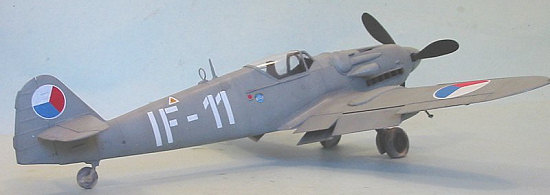 ighter
as it turned for a second attack.
ighter
as it turned for a second attack.
In the cockpit, American volunteer Lou Lenart lowered the nose and opened fire as he turned and approached from the southeast. Opposition in the form of intense 40mm anti-aircraft fire finally came up as he wheeled around for a third pass. After firing 10 rounds on this pass, the 20mm cannons slung under the wings jammed.
As Lenart flew away, Israeli pilot Modi Alon came in from the northeast and attacked the vehicles just south of the bridge. Flying through intense flak, Alon made two more strafing passes before running out of ammunition.
As Alon made his third pass, Ezer Weizman attacked from the south, dropping one bomb on vehicles south of Ashdod. On his second pass he hit the units close to the bridge. While his cannons fired only one shot each before jamming, Weizman strafed with the two 13mm cannons his airplane was equipped with.
The fourth airplane, flown by American Eddie Cohen, was not so fortunate. Hit badly by 40mm fire on his second strafing pass, the airplane was seen trailing smoke as it flew off to the north.
Lenart covered the 20 kilometers from Ashdod to the secret air base at Ekron in a matter of minutes. He landed just im time to see Modi Alon suffer failure of his left brake as he touched down. Unable to steer a straight path down the runway, Alon ground-looped the fighter, the left tire exploded, and the wingtip struck the ground as he slewed to a stop, severely damaging the airplane.
Minutes later, Weizman landed without incident. Everyone looked for number four, but there was no sign of Cohen. The telephone rang. It was Hatzor air base, reporting that an aircraft engulfed in flames had crashed near the field attempting the land. Two infantry platoons had been sent to rescue the pilot, but the Egyptians had gotten there first. Eddie Cohen was the first casualty of the new Heyl Ha-Avir.
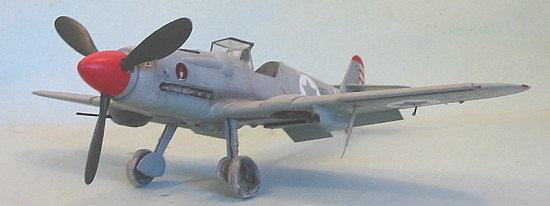 When the ground crews
checked the three remaining airplanes, they found only half the fuel tanks had
been filled before the mission.
When the ground crews
checked the three remaining airplanes, they found only half the fuel tanks had
been filled before the mission.
The Messerschmitt Bf-109 had just entered its last war, ironically in the service of those the regime it had previously served had sought to eradicate. While the airplanes were indeed Bf-109s, they were a strange variant.
While very few German aircraft of the Second World War remained in use with any air force following the end of the war, only the Bf-109 continued in production. The Bf-109G-14 had been produced in Czechoslovakia by Avia, commencing in 1944, but only a few had been accepted by the Luftwaffe prior to the end of the war. The Avia plant was still intact, which allowed continued production, and two Bf-109G-12s and 20 Bf-109G-14s still on the production line were completed and issued to the National Air Guard that summer, with the single-seater designated the S-99 and the two seater the CS-99. It was planned that more Bf-109s would be produced, but this program received a major setback in September 1945 when a sugar refinery at Krasno Bresno where the entire stock of DB605AM engines for the Bf-109 was stored was set afire, destroying all the engines.
The only other 12-cylinder inverted-vee engine available in the country in substantial numbers was the 1,350 h.p. Junkers Jumo 211F which was intended for the He-111H. The engine was really in no way suitable as a powerplant for a fighter, but it was what was available. The Czechs set out to make do. The G-14 airframe was modified to take the Jumo with a big 3-bladed paddle prop, and was designated S-199.
The conversion was entirely retrograde as regards performance. The Bf-109 was legendarily difficult to take off or land in, and the torque from the huge paddle prop only made things worse since it caused the airplane to swerve as soon as the tailwheel lifted off, requiring the constant application of rudder during takeoff and climbout. Acceleration was sluggish, the controls were over-sensitive in flight, and landing was even more difficult than taking off. Top speed was reduced from the 435 m.p.h. of the Bf-109G-14 to a claimed 367 m.p.h., though production models barely made 340 m.p.h. Production commenced in 1947. The performance of the airplane was so dangerous that pilots named it the Mezec, Czech for “mule.”
The S-199 entered the history books as more than an afterthought because of the
need of the Israelis for any fighter they could lay hands on. Following the UN
declaration in the fall of 1947 setting the establishment of the Jewish State
for the following May, an arms race developed between the fledgling state and
their Arab opponents, who were determined to strangle the baby in its
 crib. An international arms
embargo was declared, but it only affected the Jews. Egypt, Jordan, and Syria
already had established armed forces that vastly outnumbered anything the Jews
could create with their underground army, the Haganah.
crib. An international arms
embargo was declared, but it only affected the Jews. Egypt, Jordan, and Syria
already had established armed forces that vastly outnumbered anything the Jews
could create with their underground army, the Haganah.
In late 1947, Haganah agent Otto Felix, who was searching for arms in central Europe, reported the existence of the S-199, and that the Czechs - who were in need of hard currency - might be willing to overlook the embargo and sell some of the airplanes. The Haganah was optimistic that they could buy surplus American fighters that were sitting on airfields throughout Europe at them time and declined the offer.
At the same time, Haganah agent Boris Senior, who had returned to his native South Africa to try and obtain arms, found 50 P-40 fighters that had been previously sold for $1,200 and were about to be scrapped. Unfortunately, the South African government refused export permits for such obvious military items and the logistics of smuggling them out of the country proved too great. In the United States, Al Schwimmer only avoided arrest by the FBI by flying out of Miami with three recently-scrapped B-17s, leaving behind 12 P-47s in Mexico he had been negotiating to buy.
By the end of February, 1948, as the international arms embargo cracked down, the Haganah reconsidered the Czech offer. The next month, the Communists staged their coup in the country, and the democratic government of Czechoslovakia was no more. Would the Communists still be willing to consider the deal? As it turned out, they would. Josef Stalin saw the foundation of the State of Israel as an event that would potentially turn all the Arab governments throughout the Middle East against the West if the State of Israel managed to survive, thus presenting an opportunity to the Soviet Union to gain influence in the region, a traditional Russian goal since the days of the czars. Selling the Jews a few third-rate airplanes at inflated prices was an excellent investment in the future.
On April 23, 1948, Felix signed an agreement to purchase ten Avia S-199s for the ridiculous sum of $120,299 each, including weapons and ammunition, in cash, American dollars only. An additional $80,000 included the services of Czech ferry pilots. The total of $1.8 million equals $13 million in contemporary dollars. At the time, a war-surplus P-51D sold for $4,000 in Europe. Beggars can’t be choosers - Felix took an option on 15 more at the same price.
Within weeks, the arrests in Rhodes of Israeli pilots ferrying Avro Ansons to Israel ended the plan to ferry the airplanes, which had called for stops in Italy and Greece. Transport by sea would be impossible since the airplanes could be stopped in any European port. Machal, an organization of American volunteer pilots that included both Jews and Gentiles, had been established with several Curtiss C-46 Commandos, to smuggle arms into the future Jewish state. Operation Balak was set up to transport the S-199s one at a time from Czechoslovakia to Ekron in Palestine, via Ajaccio, Corsica.
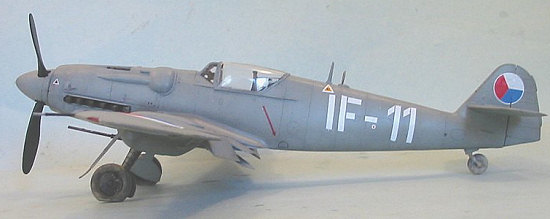 On May 6, 1948, Machal
volunteers Lou Lenart and Milton Rubenfeld, accompanied by Israeli Sherut
Avir (forerunner of the Heyl Ha-Avir) pilots Modi Alon, Ezer Weizman,
Jacob Ben-Chaim, Pinchas Ben-Porat, Itzhak Hennenson, Misha Kenner, Nachman
Me'iri, and recent American immigrant Eddie Cohen, flew out of Sde Dov in a
chartered DC-3, headed for Geneva via Cyprus and Rome, In Geneva, they took a
train to Zurich, then flew on in a Czechoslovakian Airlines DC-3 to Prague. On
May 9, they began flight training.
On May 6, 1948, Machal
volunteers Lou Lenart and Milton Rubenfeld, accompanied by Israeli Sherut
Avir (forerunner of the Heyl Ha-Avir) pilots Modi Alon, Ezer Weizman,
Jacob Ben-Chaim, Pinchas Ben-Porat, Itzhak Hennenson, Misha Kenner, Nachman
Me'iri, and recent American immigrant Eddie Cohen, flew out of Sde Dov in a
chartered DC-3, headed for Geneva via Cyprus and Rome, In Geneva, they took a
train to Zurich, then flew on in a Czechoslovakian Airlines DC-3 to Prague. On
May 9, they began flight training.
Five days later - the day of the Declaration of the State of Israel - the first ten S-199s were ready to be dismantled for shipping. Four days after that, the ten pilots learned that two Egyptian C-47s had bombed the central bus terminal in Tel Aviv, killing 42 people. The Czech instructors tried unsuccessfully to convince them to stay a few more days, since they had yet to be trained in air-to-air or air-to-ground gunnery. They replied they’d learn gunnery on real targets. The five former combat veterans - Lenart, Rubenfeld, Alon, Weizman and Cohen - moved on to Zatec airfield, headquarters of Operation Barak.
On May 20, the five pilots and a small group of Czech mechanics squeezed into a C-54 along with a disassembled S-199, ammunition, and bombs. Nearly 12 hours later, they landed at Ekron. The next night, another S-199 arrived in a C-46. The following night, a third S-199 arrived in the C-54. The Israelis decided to name the S-199 the “Knife,” or Shakeen, in Hebrew.
On May 23, the first loss was suffered when two C-46s - one carrying bombs and the other the fourth S-199 - flew in from Zatec. Thick fog covered Ekron and fires were lit to guide the two to landing. The first made it uneventfully, but the second - flown by American Norman Moonitz - failed in its attempt and headed for Sde Dov. Gunners there opened fire through the fog at the unexpected arrival. Hit in an engine and attempting to fly back to Ekron, the C-46 crashed south of Latrun. The fuselage of the S-199 broke free on impact and rammed into the cockpit, killing Polish-born American navigator Moshe Rosenbaum, and hospitalizing Moonitz for two weeks. The flights continued each night.
The crews at Ekron hid the S-199s under camouflage nets while the Czech
mechanics worked to assemble them. The General Staff wanted them in combat as
soon as possible. On May 28, Heyl Ha' Avir commander Aharon Remez
informed Prime Minister  David
Ben-Gurion that it would be at least two more days before the airplanes would be
ready, since they had to be test flown. Ben-Gurion replied that there was no
time.
David
Ben-Gurion that it would be at least two more days before the airplanes would be
ready, since they had to be test flown. Ben-Gurion replied that there was no
time.
The original plan for the first use of the new fighters had been a surprise attack on the Egyptian Air Force base at El Arish in the Sinai peninsula. However, on the morning of May 29, the Givati Brigade blew the bridge at Ashdod in the face of the main Egyptian armored advance, and appealed for air support. The first flights of the S-199s in Israel would be the real thing.
At 1700, the four Shakeens that were ready flew into history. Their attack stopped the Egyptians in their tracks, allowing the Israeli forces to hold until the first cease-fire was signed in mid-July. Without that attack, it is entirely likely that the Egyptians would have taken Tel Aviv within days and the State of Israel would have been still born.
The rest of the S-199s were flown into Israel by the end of June. The unreliability of the S-199 became painfully obvious when the war entered its second round on July 9. Ordered to attack Egyptian airfields and positions the evening of July 8, four of the S-199s were assigned to attack El Arish air base, but were only ready the next morning. One was nearly destroyed in a take-off accident and another was lost to AAA over the target. The next day, another S-199 was lost. On July 11, Syd Cohen discovered the fatal flaw of the S-199 when he decided to test-fire his guns. When he did, the cowl guns were out of synchronization and he nearly shot his prop off, but was able to make it back safely to Herzliya. After that, pilots either test-fired the cowl guns near the field or only used the wing cannon.
By
the beginning of Operation Yoav on October 15 - the
 offensive that eventually ended
the War of Independence - only seven of the 23 S-199s that had made it to Israel
were still operational.
offensive that eventually ended
the War of Independence - only seven of the 23 S-199s that had made it to Israel
were still operational.
As related in a recent issue of Flight Journal, one interesting event involved American pilot Milton Rubensfeld, who was shot down on one of the early missions, and managed to parachute onto a kibbutz. Like most of the Americans serving in the War of Independence, he did not speak Hebrew, and with his dark good looks could be mistaken for an Arab. As the kibbutzniks approached to take him prisoner, he cried out “Gefilte fish! Gefilte fish!” the only words close to Hebrew he knew, and which gave the kibbutzniks enough of a pause that he was able to produce his identification. Apparently Rubensfeld’s sense of humor was genetic, because his son Paul, who became an actor and shortened the family name to Rubens, made a name for himself as “Pee Wee Herman.”
On
October 16, the Egyptian Second Brigade retreated from Ashdod, where they had
remained since the first mission of May 29. Among the officers of the unit were
a young Major named Gamal Abdel Nasser, and his close friend and fellow
nationalist, Captain Anwar Sadat. That afternoon, Modi Alon and Ezer Weizman
attacked the retreating Egyptians. After the attack they returned to Herzliya
separately. Alon arrived first. His gear wouldn't come down. In the control
tower, Syd Antin spotted an unidentified aircraft at treetop level to the west
and radioed Alon, who interrupted his attempt to make the gear come down in
order to check it out. After identifying the bogey as a friendly, he resumed
trying to lower the gear, and managed to get one wheel down when Antin saw smoke
coming from the plane and asked Alon to check the engine temperature. Alon
replied all was well as  his
second wheel came down and he turned final. The plane was too slow and
descending too fast. The pilots of 101 Squadron watched as their most
charismatic leader crashed short of the runway and exploded. Antin always
believed that Alon pushed too hard chasing the bogey and overheated his engine
which brought glycol fumes in the cockpit, and that Alon passed out as indicated
by his unresponsiveness and the way the S-199 crashed with no attempt by the
pilot to avoid it.
his
second wheel came down and he turned final. The plane was too slow and
descending too fast. The pilots of 101 Squadron watched as their most
charismatic leader crashed short of the runway and exploded. Antin always
believed that Alon pushed too hard chasing the bogey and overheated his engine
which brought glycol fumes in the cockpit, and that Alon passed out as indicated
by his unresponsiveness and the way the S-199 crashed with no attempt by the
pilot to avoid it.
By mid-December, 101 Squadron had only six S-199s left and lost one on a take-off accident on December 15. After the first mission on May 29, no more than three S-199s were ever able to get into the air at one time. At one point former South African Air Force Wing Commander Sid Cohen - who replaced Modi Alon as CO of 101 Squadron - declared that the S-199 was the single worst airplane he had ever flown. Considering its problems, the S-199 performed far beyond any reasonable expectation. The airplane literally saved the State of Israel. It may have been a mule rather than a knife, but it was a stubborn one that gave loyal service.
| THE KIT |
The
only other conversions for the S-199 in 1/32 scale are one by Ciro and one by
ARBA, both of which are the nose only, both of which are the late-production
nose which only applies to Czech aircraft, neither of which provides the spinner
and propeller  that was most
widely used by the S-199. Both kits do however provide decals for an Israeli
S-199.
that was most
widely used by the S-199. Both kits do however provide decals for an Israeli
S-199.
This conversion kit by UMIResins is the most accurate S-199 kit available in any scale. The kit provides a full fuselage that completely replaces the fuselage in whatever Hasegawa or Pro-Modeler Bf-109 kit is used. The tall fin and rudder parts are also provided, as well as the large wheel well fairings and the larger main wheels. The kit provides the engine cowlings for both the early and late production aircraft, and both the “pointed” spinner and the “bulged” spinner, with their different-shaped prop blades. It also provides both the Erla Haube canopy and the later sliding canopy. Unfortunately, it does not provide decals. There are decals by Tally-Ho for the Czech Bf-109G-14, which provide the correct Czech national insignia and stencils, but not the letters and numbers for the fuselage serial. It is possible to obtain Israeli markings from various sources and piece them together.
While the kit parts do have flash on them, and the interior of the fuselage needs cleaning up in order for the kit cockpit to successfully fit, the result when assembled is a fuselage that looks like it was injection molded by Hasegawa themselves.
| CONSTRUCTION |
This conversion kit is a “garage kit,” and as such there are problems to be
dealt with. The parts have flash that needs to be cleaned up, though this is
not difficult. While the fuselage feels springy before the cowling parts are
attached, it is solid once these parts are assembled. The fuselage will require
Mr. Surfacer and Cyanoacrylate glue on all the joints and seams, but there is
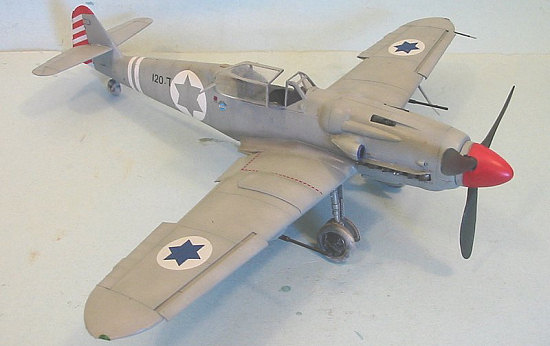 nothing difficult here or
unexpected for a limited-run garage kit. Test-fitting the fuselage subassembly
to the wing sub-assembly shows a good fit.
nothing difficult here or
unexpected for a limited-run garage kit. Test-fitting the fuselage subassembly
to the wing sub-assembly shows a good fit.
I first painted the cockpit area and then assembled the fuselage, after cleaning out the forward bulkhead area so the kit cockpit would fit inside, and then assembled the kit cockpit and installed it. I used the new Eduard multi-part 1/32 Luftwaffe seatbelts, which add realism to the final result. One could use one of the many aftermarket Bf-109 cockpits for this kit, but the standard kit cockpit looks fine.
After assembling the wing, I attached the resin wheel well fairings, which
presented no problems. The wing was then attached to the fuselage. I needed to
use both Cyanoacrylate glue and Mr. Surfacer 500 on the joints, with the end
result looking like the kit had been produced by Hasegawa. Once I had the model
painted and compared them to my Hasegawa Bf-109K-4 model, I realized that the
wheel well bulges should have been sanded down a bit more so that the edge is
not so prominent.
There has long been a consensus about the spinner and prop used by the S-199. Unfortunately, this consensus - that it was a bulged spinner with a very large paddle-bladed prop, is wrong. All the photos of Israeli S-199s during their operational service show a more pointed spinner with a more narrow paddle-blade prop. The available photos of Czech S-199s show nearly all to have also used this prop. In fact, the reason everyone “knows” that the prop was the bulky one is due to the fact that the sole surviving Israeli S-199 has one. Interestingly, the S-199 and CS-199 that survive in the Kbely Museum in Prague both have the pointed-spinner and smaller prop. My guess is that the Israeli S-199, which was put together from parts in the 1960s, ended up with the late production prop it has as a replacement from Czechoslovakia. This conversion kit provides both props, so a modeler can go either way with their project. Personally, the pointed spinner and smaller prop look better, and the S-199 needs all the help it can get in the looks department.
One thing to take special note of is that once the prop blades for either version are taken off their molding block, it is necessary to sand down the back of the blades considerably, to get the proper thickness and a circular cross section at the point where the blades are fitted to the spinner. Again, this is not difficult.
The exhausts provided, while being Jumo exhausts and therefore more correct than
the Daimler-Benz exhausts of the standard kit, which all other S-199 kits have
used, are not quite right, since they completely fill the cowling opening and
leave no room for the exhaust deflector shields. I managed to replace these
with some cut from photoetch, which were thin enough to slip
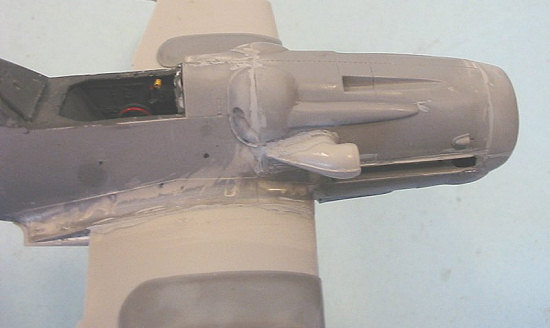 into position. UMIResin has
since discovered that the correct Jumo exhaust is the one for the Stuka, and has
already changed the mold for these. One thing to pay particular attention to is
that both sides of the exhaust use a flat shield, and the curved shield used on
the left side of the Daimler-Benz powered Bf-109 is not used on the S-199.
into position. UMIResin has
since discovered that the correct Jumo exhaust is the one for the Stuka, and has
already changed the mold for these. One thing to pay particular attention to is
that both sides of the exhaust use a flat shield, and the curved shield used on
the left side of the Daimler-Benz powered Bf-109 is not used on the S-199.
I decided to attach the sliding canopy for the Czech airplane in the closed position, as the lines of the model look better this way, in the same way that a P-51B with a Malcolm hood looks better with it closed than open. The canopy is very clear and after being dipped in Future there is no problem seeing the cockpit interior. While the kit provided a vacuformed Erla Haube canopy, I had an injection part in the spares box and decided to use that.
| COLORS AND MARKINGS |
Painting:
The S-199 came in an overall paint scheme of RLM 02 Grey-green, though some
earlier researchers mistook photos of Czech S-199s taken with orthochromatic
film as evidence these airplanes were painted some shade of dark green overall.
However, the restored S-199 at Kbely is obviously in RLM 02. After applying
“pre-shading” to the panel lines with flat black, I used Xtracrylix “RLM 02,”
which I lightened with some Xtracrylix “Light Aircraft Grey” to post-shade and
fade the paint. I “sun-faded” the Israeli airplane by adding in Xtracrylix
“White” and going over the airplane with a very thinned coat. I painted the
rudder white, then masked it off and painted the red strip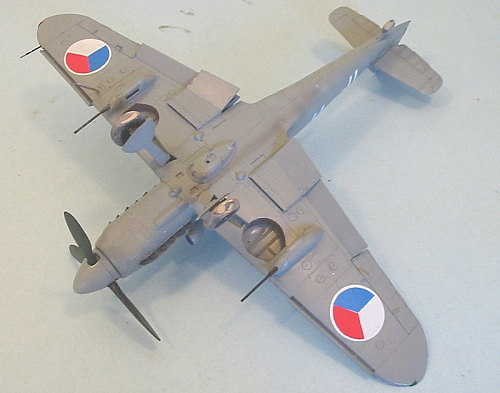 es
and prop spinner with Tamiya Flat Red. The propeller blades for both models were
painted with Xtracrylix “RLM 70 Dark Green.” I also painted the fuselage
stripes White and masked them off.
es
and prop spinner with Tamiya Flat Red. The propeller blades for both models were
painted with Xtracrylix “RLM 70 Dark Green.” I also painted the fuselage
stripes White and masked them off.
Decals:
I decided to do the well-known D-120, as it appeared in September 1948 following its crash in June 1948 and subsequent rebuild. The Israeli S-199s went through several different stages of markings, beginning with rather small Star of David insignia and then progressively repainting these larger for identification purposes. I had a set of decals from the Kiwi Resins conversion which had been too big for the 1/48 kit, but which were the right size for the original small wing insignia and also provided the serial number. I used a large Star of David decal from a SuperScale sheet for Israeli Spitfires, with the center cut out. There has been controversy over whether this fuselage insignia had the blue Star of David, but examination of the well-known photo of this airplane taxying for takeoff shows the Star of David is the same shade of grey as the fuselage. This would comport with an insignia that was in the process of being repainted in a larger format than originally applied. I used the 101 Squadron insignia from the Kiwi Resins sheet, which is actually slightly too small, but there was no other alternative. The other markings and stencils came from the kit decal sheet.
At first, doing the Mezec gave me fits, since there were no decals available. Eventually, I sourced some white circles from a Tamiya Spitfire sheet, and used those for the wing insignia, cutting the red and blue sections from solid-color decal sheets. I found the Czech national insignia used on the rudder on a decal sheet left over from another project. The serial number was done using a sheet of white stripes, cut to size for the letters and numbers.
| FINAL BITS |
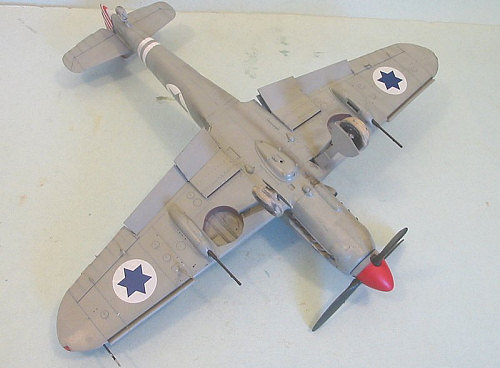 The paint on the S-199s
was originally semi-gloss. For the Czech version, I applied a coat of
Xtracrylix Satin varnish, since this airplane would likely have been
well-maintained. The Israeli version was given several coats of Xtracrylix Flat
Varnish to get the sun-baked flat finish it would have had after several months
in the desert environment. I also “muddied up” the wheels with the Tamiya
“weathering makeup kit” and applied exhaust stains with Tamiya Smoke. I didn’t
further ding the models, as the available photos of the Czech versions show them
to be pretty clean, and the photo of D-120 shows that the airplane had not had
that much time to be dinged after its repair.
The paint on the S-199s
was originally semi-gloss. For the Czech version, I applied a coat of
Xtracrylix Satin varnish, since this airplane would likely have been
well-maintained. The Israeli version was given several coats of Xtracrylix Flat
Varnish to get the sun-baked flat finish it would have had after several months
in the desert environment. I also “muddied up” the wheels with the Tamiya
“weathering makeup kit” and applied exhaust stains with Tamiya Smoke. I didn’t
further ding the models, as the available photos of the Czech versions show them
to be pretty clean, and the photo of D-120 shows that the airplane had not had
that much time to be dinged after its repair.
| CONCLUSIONS |
This is an excellent resin conversion kit, that presents no difficulty to any modeler who has done at least one other short-run resin conversion, and which results in the most accurate model possible of an historically-significant airplane in any scale the S-199 has been produced in. Those “109 nuts” who want at least one of every sub-type of the Augsburg Eagle in their collection of big 109s will be happy with this S-199, whichever version is built.
Note that UMI Resin is out of business.
April 2007
Copyright ModelingMadness.com. All rights reserved. No reproduction in any form without express permission from the editor.
If you would like your product reviewed fairly and quickly, please contact the editor or see other details in the Note to Contributors.